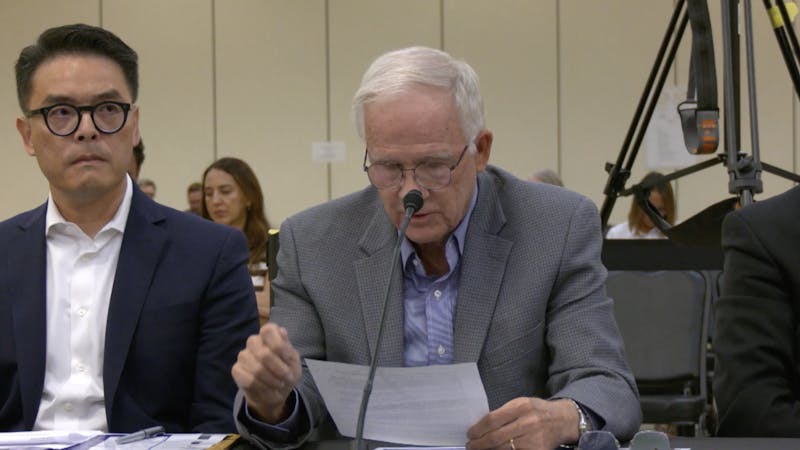Molecular Jackhammers present novel method of eradicating cancer

Mark Munyi / Thresher
Rice, MD Anderson and Texas A&M researchers have developed a novel method of eradicating cancer with a nanoparticle that shakes so hard, it can break apart a cell.
These molecules have been coined “molecular jackhammers,” and researchers hope to use them to target difficult-to-treat cancers such as pancreatic cancer. Since the molecular jackhammers only target cancer cells and require specific light activation to vibrate, they are relatively safe to use and are expected to reach human clinical trials within five to seven years.
“It’s a completely new type of therapy,” Thomas Killian, dean of the Wiess School of Natural Sciences, said.
This nanoparticle is biocompatible, selectively binds to the membranes of cancer cells and has a vibronic mode that can be activated by near-infrared light. Upon activation, the nanoparticles vibrate at 40 trillion oscillations per second, introducing a mechanical force that rips apart the tumor cell membrane, destroying cells within minutes.
A paper describing the study was published in Nature Chemistry late December. Ciceron Ayala-Orozco was the lead author of the publication and is a researcher with the chemistry department in the Tour group. The researchers observed a complete eradication of melanoma, a type of skin cancer, in petri dishes and a 50% efficacy in mice with melanoma.
“The tumors never came back,” said James Tour, a chemistry professor and the study’s senior investigator. “We knew we were really on to something.”
Previous attempts at similar mechanisms used visible or ultraviolet light, neither of which could penetrate the body farther than a couple of millimeters. Near-IR can penetrate up to 10 centimeters deep.
“This could allow you to get a much more deep-seated tumor,” Tour said.
The molecular jackhammers belong to a class of molecules called cyanines, which are commonly used as dyes for molecular imaging. Some cyanines are already approved by the Food and Drug Administration, Ayala-Orozco said, which should accelerate the jackhammer’s track to clinical usage.
Ayala-Orozco explained that there are already three intrinsic safety measures in the molecular jackhammers. First, the molecules have an affinity to bind to tumors over other cells. Second, the effective concentration of molecular jackhammers needed to eradicate a tumor is very low and non-toxic. Finally, the vibronic mode is only activated upon direct light.
“We can safely destroy the tumor,” Ayala-Orozco said. “It’s a localized treatment, and we have some level of selectivity towards the tumor and not healthy tissue.”
According to Ayala-Orozco, the nanoparticle is small enough to bypass macrophages, cells in the immune system that eat and destroy substances foreign to the body. Killian adds that the molecular jackhammer’s mechanism makes it unlikely for cells to develop drug resistance to it.
“For a whole host of reasons, it really looks very exciting. It opens up a whole new scheme for attacking cancer cells,” Killian said.
Ayala-Orozco’s graduate study involved investigating gold nanoparticles that oscillate rapidly upon near-IR activation. During his post-doc, he wanted to move away from larger, inorganic nanoparticles that macrophages easily sequestered. He eventually joined the Tour group, which studies small, organic molecules that have the propensity to mechanically damage cells. These molecules, however, are activated by visible or phototoxic UV light, which can only penetrate the body by a couple of millimeters.
“At some point, I connected the dots,” Ayala-Orozco said.
The study took one year of work before submission, and one year of revision before publication.
According to Killian, an interesting aspect of the study is that it applies the fundamental connection between electronic motion and molecular vibrations to a health problem.
“I always like seeing these applications or discoveries that emphasize how important the fundamental discoveries are for making new advances,” Killian said.
Tour agrees that it was important to validate the details of the study.
“There’s a lot of physical chemistry [needed] to figure out what’s going on here,” Tour said.
The next steps to this project include testing the tiny jackhammer’s efficacy on pancreatic cancer. According to Tour, pancreatic cancer poses a number of problems that make it difficult to both diagnose and treat. Tumors tend to form a stroma, or a hard shell, around it, making drug delivery difficult. A major artery also runs through the pancreas, complicating surgery. The duodenum, an organ located behind the pancreas, would be destroyed with the amount of radiation necessary to knock out the cancer.
“The average lifetime from the time of diagnosis is about a year,” Tour said. “The hope is that these molecular jackhammers will pound their way right through the stroma and right on into the tumors.”
The team is already in a partnership with a company working on gaining FDA approval and licensing.
“It could be within five, seven years that the first clinical trials in humans start,” Ayala-Orozco said.
Ayala-Orozco published another paper detailing how to build these molecular jackhammers early this January. According to Tour, yet another paper has since been submitted and a fourth is on the way.
“You spend years in the wilderness, and then all of a sudden something works. When you find something that works, you get a massive number of publications very quickly, because everything is just turning over,” Tour said. “[Ayala-Orozco] is in this rapid-fire publication mode.”
According to Killian, the discovery is exciting for the Chemistry department as one of many steps to expand research into health applications, especially with the Texas Medical Center so close.
For students looking to solve big problems like cancer, Killian points to elucidating the fundamentals.
“We still need breakthroughs in our basic scientific understanding of how cells, molecular chemistry and physical chemistry work,” Killian said. “The horizons are wide open to make a great impact, if you pick an important problem, dig deep into it and look for creative ways to do things that no one’s ever thought of.”
Ayala-Orozco agrees, encouraging young scientists to think outside the box.
“Don’t be discouraged if the strategy or approach you are proposing goes against known literature at the moment,” Ayala-Orozco said. “We as scientists should not follow or repeat everyone else.”
More from The Rice Thresher

Rice announces Chao College as 12th residential college
Rice announced that the 12th residential college will be named Ting Tsung and Wei Fong Chao College Aug. 19. The college, set to open in fall 2026, will contain nearly 300 on-campus beds.
Dining access fund announced following on-campus unlimited meal swipes
Rice announced new food assistance programs on Tuesday to account for the controversial change in the on-campus meal swipe plan.

Rice disaster prediction model discussed at hearing on deadly Central Texas floods
The House and Senate Select Committees on Disaster Preparedness and Flooding held a hearing on July 31 in Kerrville to address the deadly July 4 flooding in Central Texas. The flooding along the banks of the Guadalupe River killed 108 people, including 37 children. In the charged hearing, Texas lawmakers and flood survivors criticized the local response to the disaster.


Please note All comments are eligible for publication by The Rice Thresher.